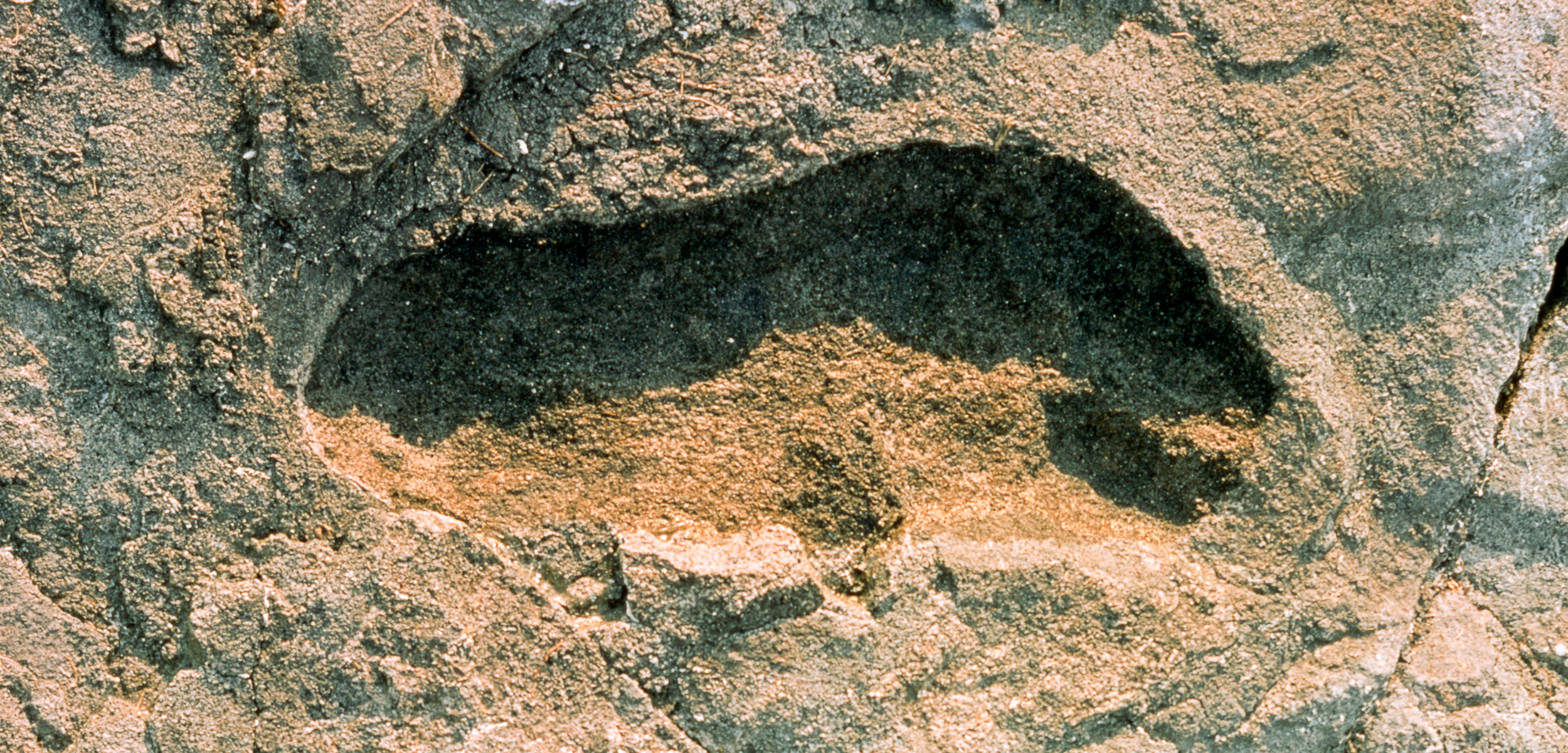Where Our Human Ancestors Made an Impression
Coastlines around the world boast hints of ancient humans who gathered and traveled along the edges of the world, where land meets sea.
Article body copy
Just below the South African village of Brenton-on-Sea, there’s a beach that looks like something out of a tourism brochure: a tiny, sheltered bay with 50 meters of sandy beach at low tide, backed by 100-meter sea cliffs rising into a blue sky. Right where sand and cliffs meet, there is a low-ceilinged cave carved out of the surrounding stone by pounding waves.
Charles and Linda Helm, along with Guy Thesen, a friend and colleague, came across this coastal gem one day in 2015. They waited for low tide before venturing in. Linda entered first. Not far beyond the cave’s entrance, she spotted a pattern on the ceiling. “I think there’s something up here you’ll want to see,” she said, turning back toward her husband. Protruding from the sloped ceiling—as though pressed down from above—were what looked like human tracks, the kind of foot-sized divots that might be left behind in loose sand.
The trio thought the tracks might be human. But they were without toe impressions, clear heel marks, or distinct edges. Tired after a long day and without the equipment to properly document the finds—or even flashlights—they reluctantly moved on.
The next year, they returned and were relieved to find the tracks still there. Crawling on his back deeper into the cave, Helm found nine more prints, this time with toe impressions intact, situated on the ceiling just 50 centimeters above the cave floor. They were clearly human—and it looked as if whoever made the tracks was running.
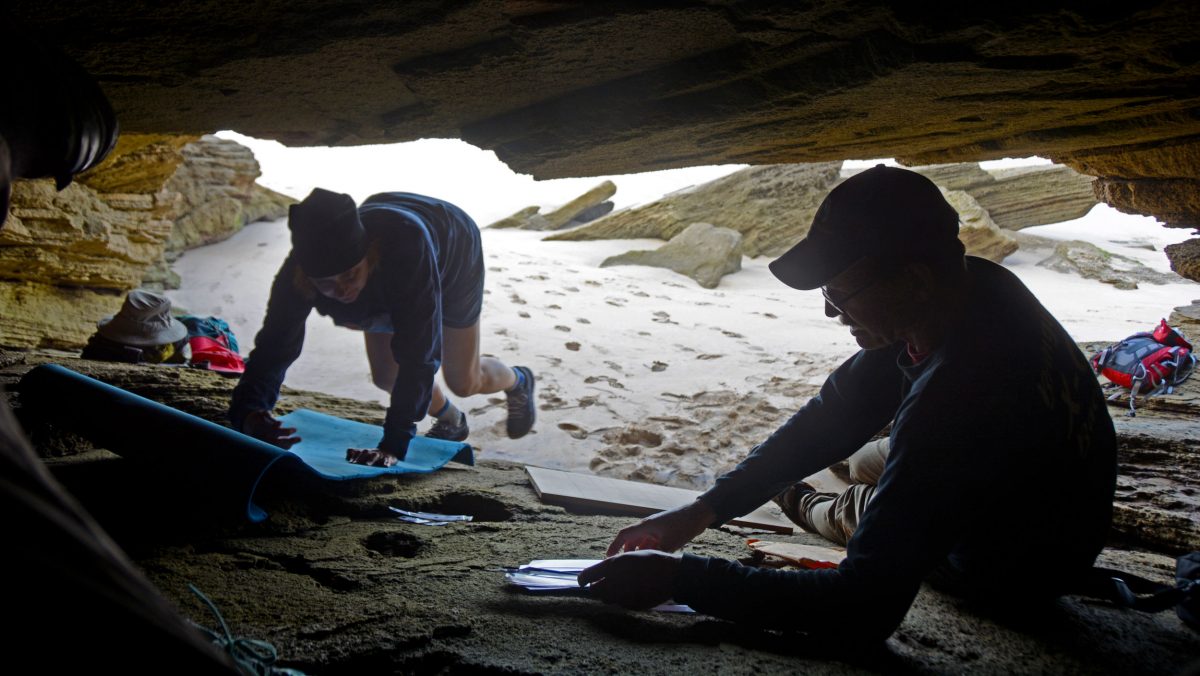
Charles Helm, right, and his wife, Linda, work in the cave on the South African coast where they found ancient footprints. Photo by Charles Helm
Helm, a retired family physician who spends most of the year in remote Tumbler Ridge, British Columbia, is also something of an expert on footprints. He has spent close to two decades looking for very, very old tracks of all kinds: not long after emigrating to Canada from South Africa in the 1980s, his eight-year-old son helped discover dinosaur footprints near their new home. Helm and his family later helped establish the Peace Region Palaeontology Research Centre in the town, now a tourist destination thanks to dinosaur tracks left behind 100 million years ago.
Over the past decade, Helm has spent his summers back in South Africa, on a mission to look for footprints. He, his family, and colleagues at the African Centre for Coastal Palaeoscience have surveyed more than 275 kilometers of South African coastline, locating over 100 sites with animal tracks dating back 100,000 years or more.
The fossilized footprints re-create a vanished world, full of lions and elephants, buffalo and horses. Helm has even found giraffe tracks, evidence that the landscape was dotted with trees. “One giraffe track and you have an entire paleoecological reconstruction,” he says. “You get the sense it’s teeming with wildlife.”
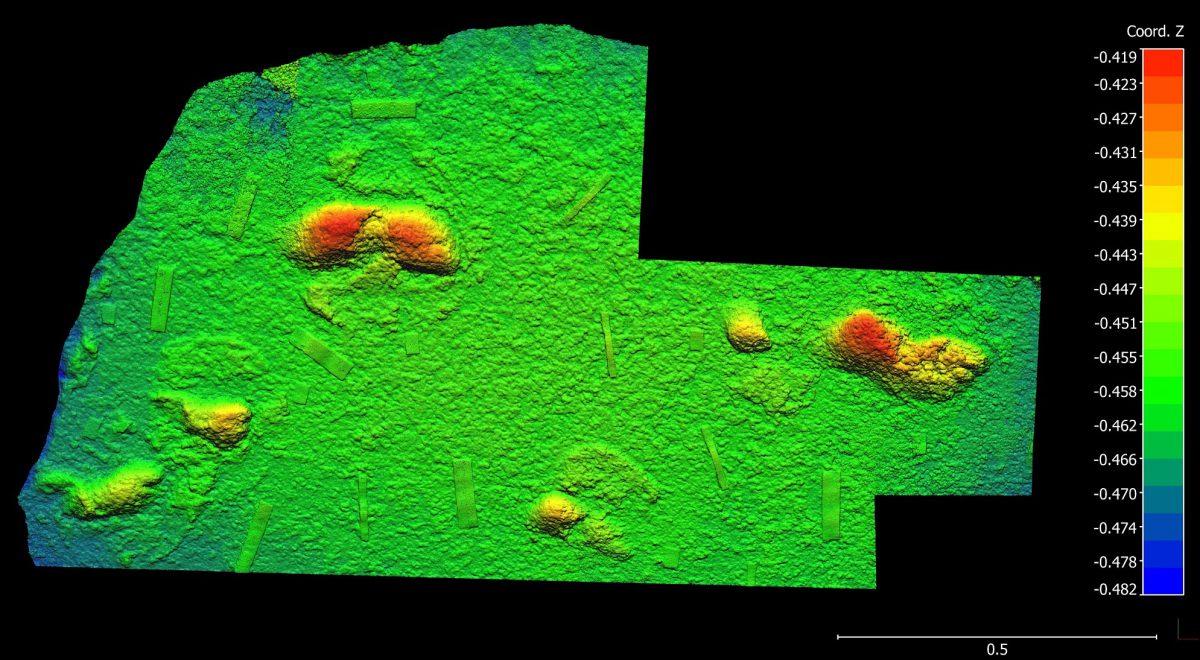
Hours of 3D photogrammetry work reveal the tracks of ancient humans on the South African coast. Photo by Richard McCrea
Dinosaurs, elephants, and giraffes were all exciting enough. But when he found those familiar-looking footprints in 2016 protruding from the roof of the cave as though embossed, Helm was really moved. More personal than stone tools, more dynamic than skeletal remains, human footprints create an unparalleled link to the distant past. The analysis of preserved human and animal footprints—known as ichnology, from the Greek word for track—allows us to imagine people not so different from us, standing, running, and playing, hundreds or thousands or even millions of years ago. “Tracks are more exciting than body fossils,” Helm says. “They can tell a story.”
Human tracks encode a startling amount of information, enough for scientists to create a brief, but illuminating, biography of a person or group of people. The average person takes an estimated 224,000,000 steps over the course of a lifetime. When preserved, footprints are a library of clues about a human’s activities, speed of travel, height, weight, and sometimes even sex. They are, however, remarkably rare in the archaeological record. At a conference in Cologne, Germany, last year, researchers from around the world gathered to compare notes on some of the most prominent finds.
Some of the sites were well known: prehistoric human tracks have been found on fossilized lakebeds in Saudi Arabia, deep inside caves in France, and pressed into the ground in Tanzania. The oldest ever found, made by a group of early hominins walking through wet volcanic ash in present-day Tanzania, date back 3.6 million years.
In the past few years, researchers have found them in unexpected places scattered around the world: modern beaches. Finding ancient footprints in such a dynamic environment seems counterintuitive. Is there anything more ephemeral, after all, than footprints in the sand? You’d think that the action of waves and wind would wipe footprints away quickly. But, in 2012, massive storms in Wales revealed fossilized forests—and the footprints of a child, facing a prehistoric sea. In 2013, researchers stumbled across the 800,000-year-old tracks left behind by children and adults, a small family perhaps, playing on a windswept English beach. The following year, researchers working on British Columbia’s Calvert Island found footprints dating back to the earliest days of human presence in the Americas. The one thing they all have in common is proximity to the ocean.
The most basic of human imprints—footprints—are found around the world’s coasts. Illustration by Mark Garrison
“It turns out under very specific conditions, coastal regions can be ideal for preserving tracks,” says Duncan McLaren, an archaeologist at the University of Victoria in British Columbia and Hakai Institute scholar, who reported finding the footprints on Calvert Island. And shorelines are places where footprints are more likely to be found, simply because people spend a lot of time there. Coasts tend to be places where intense human activity is concentrated in a narrow space.
And the distinct geology of some seashores lends itself to preserving otherwise fleeting evidence like footprints. “Coasts have a lot of soft sediment where tracks or footprints are easily made or left,” says McLaren. “Then wind or wave action fills them with sand or silt.”
Over time, those sand or silt layers build up to protect the prints—until they don’t. Coastal erosion, wind action, or archaeological investigations can strip away sediment, uncovering artifacts and footprints layer by layer.
A big storm sometimes reveals the most exciting archaeological finds. “As soon as that happens, we’re out there working flat out looking for this stuff,” says Martin Bates, a geoarchaeologist at the University of Wales.
In a way, the rising seas and stronger storms that come along with climate change are a gift to archaeologists looking for coastal footprints. “The more coastal erosion, the more we see,” Bates says. “Sea level rise will destroy this archive as it reveals it.”
There’s one other thing about coastal footprint finds: once they’re exposed, they’re almost impossible to preserve. Whether it’s a matter of years, weeks, or days, footprints are bound to disappear. “Seeing is destruction,” says the University of Cologne’s Tilman Lenssen-Erz, the German archaeologist who organized the Cologne conference. “One has to chance upon the exact right moment to open tracks up to human view.”
Archaeologists can’t always pick their moment, of course. In May 2013, Nicholas Ashton, British Museum curator and deputy director of the museum’s Ancient Human Occupation of Britain project, was unpacking geophysics equipment at a beach in Happisburgh (HAYS-buh-ra), near Norwich on England’s east coast about 200 kilometers from London. The plan was to search for topographical features without having to dig.
Ancient estuaries, dating back more than a million years, lie buried beneath tall cliffs overlooking Happisburgh’s beaches. “As the sea encroaches, the cliffs erode back and reveal the ancient estuary beds,” Ashton explains. In 2000, a local dog walker spotted a flint hand-ax Ashton dated to 500,000 years old. Since then, archaeologists and volunteers have recovered hundreds of bones and antlers from animals that roamed England a million years ago, including red deer, giant elk, mammoths, and an ancestor of the horse.
As the tide receded on that blustery day five years ago, Ashton’s colleague Martin Bates spotted a scatter of what looked like human footprints on the beach, pressed into a layer of firm, dark clay that had just been exposed by the tide—a clue that they had been made a long time ago. “It was an unusual spot of clay, with unusual humps and bumps,” Bates says. “I thought they might be footprints, but the rest of the team took a little bit of convincing.”
After taking a closer look, Ashton still wasn’t sold. “He pointed to these elongated recesses and said, ‘These are footprints,’” Ashton recalls. “I was deeply skeptical.” It was morning, and Ashton, a veteran archaeologist, knew he had just four or five hours to document the tracks before the next high tide further eroded the hardened mud layer containing the footprints. Trying to remove the footprints was futile: each one, captured with silt around it, would weigh 50 kilograms or more.

For a while, researchers could look at the surface of the beach and see human footprints created almost a million years ago and then preserved until revealed by a storm. Photo by Simon Parfitt/Ashton et al.
To top it off, it had begun to rain. “The weather was absolutely foul. It felt more like January than May,” he says. Ashton decided to take pictures. With enough still images, he could use computer technology to knit the photos into a three-dimensional image. With any luck, there would be enough information to understand who left the prints and when.
Working quickly, he took hundreds of pictures from every angle. Other members of the team used sponges to remove seawater from the deepest prints and brush away sand. “It was a fight against time, a fight against the rain, and a fight against sand blowing into the hollows,” Ashton says. “I came off the beach feeling very pessimistic.”
Luck, however, was on his side. The image that emerged later exceeded his expectations. Dotted across an area about eight meters by four meters were nearly 50 footprints. The tracks were clear enough to distinguish five or six different individuals. Based on the length of the prints, a physical anthropologist at Liverpool John Moores University was able to estimate the height of the individuals. (Feet are roughly 15 percent of a person’s height.)
Analyzing the digital reconstruction, the anthropologist, Isabelle de Groote, estimated that there were about a half-dozen people milling around in the mud, including several children. The prints were made long before modern humans walked the Earth, most likely by an early hominin called Homo antecessor—the earliest-known human species in Europe. No complete Homo antecessor has ever been found, and anthropologists aren’t sure what they looked like—but think they were tall (with males averaging 175 centimeters, and females around 160 centimeters) and not so different from us, though slightly smaller-brained.
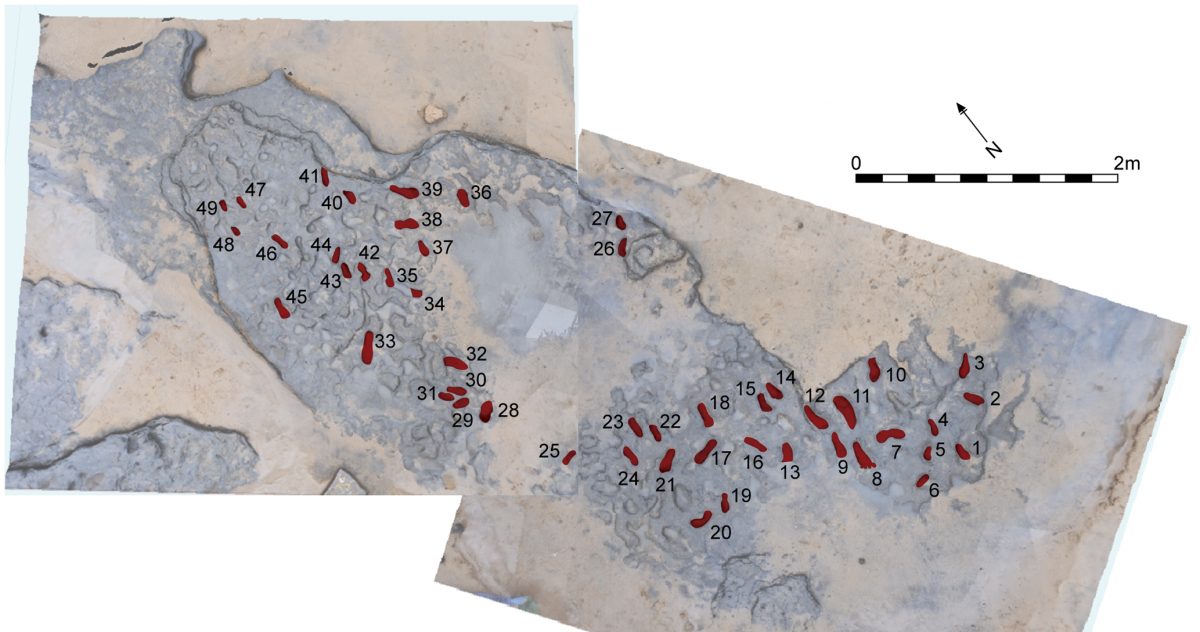
Photogrammetry of the Happisburgh footprints shows the group’s orientation and direction. Photo by Ashton et al.
Homo antecessor bones have been found in Spain, but the Happisburgh prints give archaeologists a different perspective on the ancestral species. They show a group, revealing its size and individuals of a mix of ages, lingering for a while on a mudflat, Bates says. “It’s a snapshot of a morning or afternoon 900,000 years ago. We’d never get that from stone tools.”
The Happisburgh footprints are a good example of how a specific set of circumstances can come together to preserve footprints for millennia or more. Start with sediments: mud, clay, silt, and peat will work. They need to be soft enough to make footprints but not too soft, or the print won’t retain its shape.
Next, put people or animals into the mix. Then—and this part is key—the freshly made tracks have to be buried quickly, before they have time to wash away or collapse. Windblown sand works. So will a gentle wash of water. “At the edge of an estuary, where the tide comes in twice a day and brings in mud, is a perfect place,” says Bates. “All in all, you need a sort of Goldilocks scenario—not too firm, not too wet, buried quickly—to be preserved.”
Between 850,000 and 950,000 years ago, everything came together just right, Bates says. Happisburgh’s ancient mix of tidal mudflats and silt were a recipe for preservation: after the footprints were made, the next few days of tides dropped a layer of sand and then a layer of silt into the depressions, creating a negative cast. Hundreds of thousands of years later, the fill was the first to be washed away, revealing the hardened footprints underneath.

No full skeletal remains of Homo antecessor have been found, but based on available evidence, researchers have an idea of how they may have looked. Illustration by Mauricio Anton/Science Photo Library
The resulting picture is evocative. There was a pattern of movement to the south, but no clear trails, and the footprints aren’t marching in line. They’re a mess: wandering this way and that, stepping past and behind each other. “It provides a wonderful, tangible link to the deep past,” Ashton says. “Here we have a family group walking along the estuary, behaving the way families always behave, slinging mud and running in circles a million years ago.”
The family at play is more than a touching scene. It offers a possible answer to one of the questions archaeologists have long puzzled over: how did such an early species survive in the cold of northern European winters? A million years ago, temperatures in this part of England would have been at or below freezing in the winter, a little cooler than they are today.
Archaeologists have suggested early humans may have migrated seasonally, sending their hardiest adults on long treks north during warmer summer months and spending the winters in warmer parts of the continent—perhaps as far south as modern-day Spain.
But finding a collection of footprints from adults and children effectively rules out that possibility. “It’s inconceivable that a family group would do that,” Ashton says. The distance and terrain would have been too much for small children. If they weren’t migrating, these early humans must have had some way to deal with the cold, whether it was a different physique, clothing, mastery of fire, shelters, or a combination of all those. Unfortunately, the only Homo antecessor artifacts to turn up at Happisburgh so far are simple flake tools—not enough to tell archaeologists much about day-to-day life on the ancient tidal flats.
Five years after that rainy day on the beach, Ashton still dreams of finding more footprints—or a Homo antecessor bone that would fill out the picture of early human presence at Happisburgh. He’s organized a network of local volunteers who walk the beach after big storms, searching for fragments of the past uncovered by the waves. But another spectacular find might be hoping for too much. “I occasionally wake up and pinch myself and think, did that really happen?” Ashton says. “It’s such a rarity.”
Coastal footprint finds aren’t just uncovered by happenstance, chance intersections of waves, erosion, and sharp-eyed observers. Sometimes it’s archaeologists who actively peel back layers of soil to reveal tracks from the past. In 2014, far to the west of Happisburgh, Duncan McLaren was working in the intertidal zone on the edge of remote Calvert Island, off British Columbia’s central coast, when he found a footprint pressed into a patch of sediment 60 centimeters below the surface. The site was near a large shell midden, evidence of prehistoric activity in the area, and about where McLaren and his team estimated the prehistoric shoreline would have been.
It was an accidental find, McLaren says. “We weren’t looking for footprints, we were [looking for] shorelines from 10,000 to 13,000 years ago,” McLaren says. “I didn’t realize what we had.”

In 2013, researchers found footprints on Calvert Island, British Columbia, dating back to the earliest days of human presence in the Americas. Photo by Grant Callegari
McLaren and his team—which included representatives from local First Nations groups, most likely the descendants of the First Peoples in North America—took samples from the footprint, including bits of wood and other organic matter that had been pressed into the earth. They also took pictures then covered up the print. Over the next two years, they came back to the isolated site—reachable only by boat—and dug a pit four meters long and two meters wide. The excavation eventually revealed 28 more prints, belonging to at least two adults and a child.
The footprints were preserved much like those at Happisburgh: people walking along the prehistoric high tideline pressed their feet into wet, firm clay. Not long afterward, black sand and pea gravel washed into the depressions, filling them up.
To date the footprints, McLaren used the twigs that had been pushed into the bottom of the tracks. The results took him aback. “Once we got the dates back, they were a little older than 13,000 years,” he says.
Archaeologist Daryl Fedje excavates the footprints found on Calvert Island. Video by Grant Callegari
The prints are not the earliest sign of people in the Americas. Older dates have been found as far south as Chile. But Calvert Island’s location, separated from the mainland by five kilometers of open water, is circumstantial evidence of another sort. For almost a century, theories about the arrival of humans in the Americas have been focused on the Bering Strait and a land bridge that once spanned the gap between Asia and North America.
Almost a century ago, archaeologists argued that spear-toting hunters from Asia followed wooly mammoths across the land bridge into North America and then through an ice-free corridor east of the Rockies around 11,000 years ago, quickly colonizing two continents. The idea has been conventional wisdom for decades.
But finds like the footprints on Calvert Island point to a different scenario altogether, one that was radical only 20 years ago. Researchers are calling it the kelp highway hypothesis: humans were in the Americas as early as 15,000 years ago, at a time when the Bering Strait was a land bridge, but the evidence suggests early Americans also traveled by boat. Island-hopping from Asia to the Pacific coast of Canada, early Americans would have relied on abundant marine resources—fish, seals, and shellfish—as some settled down and others worked their way farther and farther south.

The archaeology team on Calvert Island helps uncover ancient footprints at a site near the Hakai Institute. Coasts, with their soft sediment where tracks are easily made, are likely places to find ancient footprints. Photo by Grant Callegari
Archaeologists have never found boats that old in the Americas, or anywhere else. But the Calvert Island tracks strongly suggest that humans not only possessed the technology but were adept at using it. “There were people here early, on an island they could only have reached by boat,” McLaren says. “That conjures a very different image of what these people were doing.”
Lying on his back, his nose just a few handbreadths from footprints protruding from the ceiling of a South African cave, Charles Helm tried to figure out how to document the footprints in the Brenton-on-Sea cave.
How they got onto the roof of the cave was clear, at least to a fossil footprint veteran like Helm. Around 90,000 years ago, the nine protruding tracks had been formed much like the ones at Happisburgh and Calvert Island. A group of modern humans running down a dew-kissed dune pressed their feet into firm sand. Before their footprints dried and collapsed, a wind picked up sand and blew it into the depressions. Over the millennia, the sand was packed into aeolianite, a type of limestone cliff formed from coastal dunes.
Over time, waves, winds, and rising seas eroded the aeolianite layers one by one. Not long before Helm and his wife entered the seaside cave, waves washed away the layer of sediment immediately below the footprint. What was left was the impression that had been pushed into the layer from above. The result was a natural cast, pitched at 20 degrees, just like the slope of the ancient dune.
Working at low tide, Helm used a camera to document the tracks, allowing a colleague to later take those 2,000 still images to make a 3D map of the cave ceiling. It took him 10 days to photograph the prints. “It was incredibly challenging,” he says. “The tracks are right in your face.”
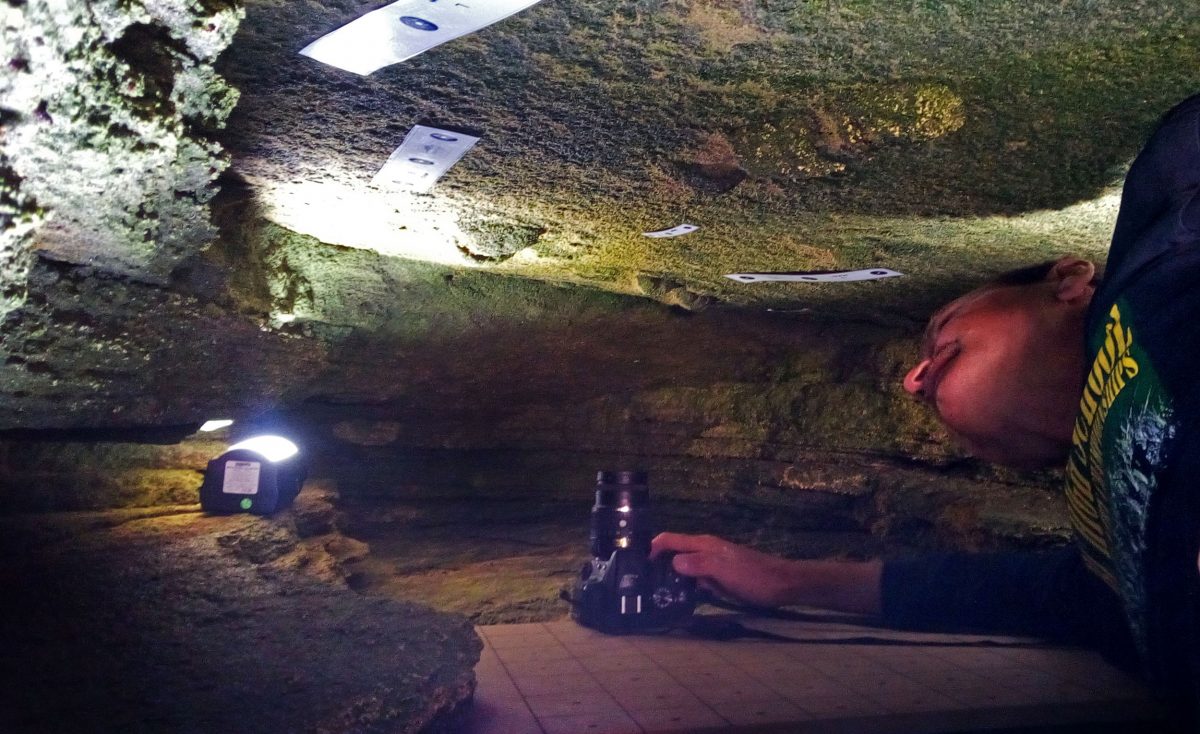
Charles Helm photographs the footprints his team found in a South African coastal cave. Photo by Guy Thesen
The result, which Helm published in the journal Scientific Reports in February, is the only known record of Homo sapien tracks from the time period—the next modern human footprints are found 44,000 years later, at a site in Theopetra Caves in Greece. The footprints were made in an era when modern humans were just beginning to thrive and spread. It’s a thought that makes Helm emotional. “This is probably the most important discovery I’ll make in my lifetime. These were our species, most likely our ancestors,” he says. “These are our grandparents, 3,600 generations removed. Every human on the planet can look at these tracks and say, those were my grandparents.”
This summer, Helm will be back in South Africa, walking along the beach looking for more footprints. It’s a trip he looks forward to every year, a chance to return to the country where he was born and explore its deep past.
On a snowy April morning in Tumbler Ridge, half a world away, his mind is already on the sun-kissed South African coast. Five hundred meters away from the cave where he found the footprints—in the direction the running tracks are pointing—there’s another cave, a hollow in the rocks that would have overlooked the dunes where the footprints were made long ago and where archaeologists have found stone tools and other evidence of early human occupation. “That cave would have been there back then, and these people were moving towards it,” he says. “We have no proof, but we think that was home. That’s a neat thought.” Easy to overlook, hard to find, footprints are a powerful link connecting us to the people who walked the Earth long ago.
*The research of Duncan McLaren is supported by the Hakai Institute. The Hakai Institute and Hakai Magazine are separate and independent agencies of the Tula Foundation.

